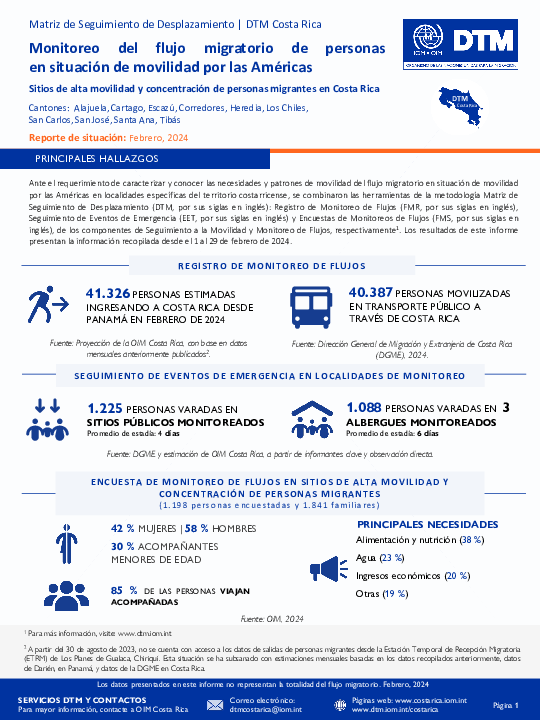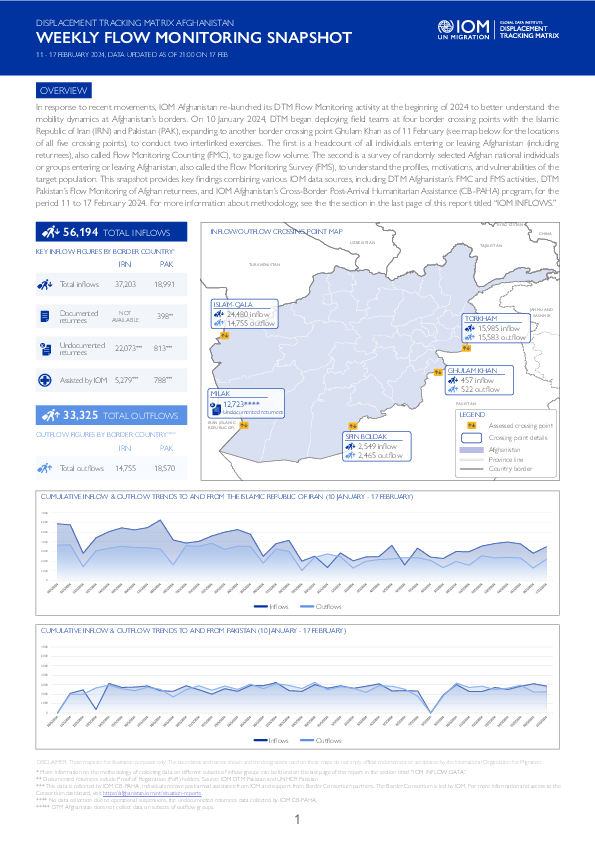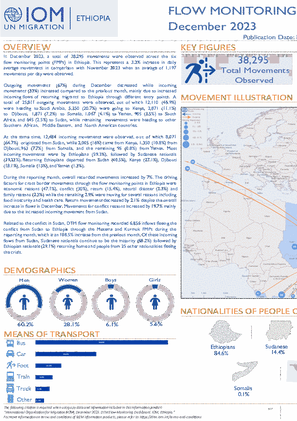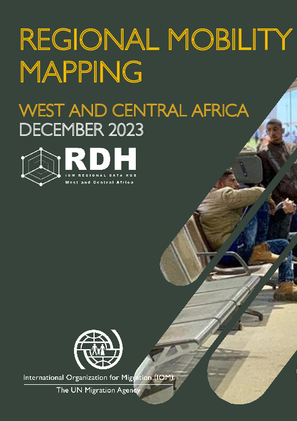-
Countries
-
Data and Analysis
-
Special Focus
-
Crisis Responses
Compilation/Overview
Color
white
Monthly Overview of:
- Arrivals in the Western Balkans
- Top three nationalities at arrivals in the reporting month
- Migrants presence in reception facilities
- Assisted Voluntary Returns and reintegration

Contact
Angélica Madrigal amadrigal@iom.int
Language
English
Location
Costa Rica
Period Covered
Feb 01 2024
Feb 29 2024
Activity
- Survey
- Registration
- Flow Monitoring
Cantones: Alajuela, Cartago, Escazú, Corredores, Heredia, Los Chiles, San Carlos, San José, Santa Ana, Tibás
Costa Rica, al igual que los demás países de la región centroamericana, se ha caracterizado por ser un corredor migratorio para personas que transitan de manera terrestre desde el sur hasta el norte de América y que tienen como destino los países del norte del continente. Este flujo en situación de movilidad por las Américas se encuentra compuesto principalmente por personas de la República Bolivariana de Venezuela, Cuba, Haití, Ecuador, así como personas provenientes de otros países de Suramérica, África y Asia.
Según estimaciones de la OIM Costa Rica, durante febrero ingresaron al país 41.326 personas, un promedio aproximado de 1.425 personas por día y estimando un aumento de un 10% con respecto a enero de 2024. Además, se identificaron 1.088 personas varadas en los albergues monitoreados y 1.225 personas varadas en los sitios públicos visitados.

Contact
DTMUkraine@iom.int
Language
English
Location
Ukraine
Snapshot Date
Mar 14 2024
Activity
- Survey
The General Population Survey is a highly representative assessment with 20,000 random respondents interviewed, providing population data and enabling an assessment of the geographic distribution of the war-affected populations across the country.
Over the course of March 2022 to January 2023, the IOM’s Data and Analytics successfully carried out 12 rounds of the General Population Survey. Initially conducted bi-monthly and later transitioning to a monthly frequency, the results were extrapolated at both national and macro-regional levels. As of May 2023, the survey methodology underwent adaptation to generate quarterly representative data at the oblast level, thus facilitating localized analysis.

Contact
dtmsupport@iom.int
Language
English
Location
Global
Period Covered
Oct 06 2023
Oct 07 2023
Activity
- Other
The International Organization for Migration (IOM) and Snowflake held a two-part hackathon in London in collaboration with University College London (UCL) (6-7 October 2023) and in Nairobi (23-26 October 2023). The hackthons presented a unique opportunity for IOM to enhance key technical processes related to data collation, compilation and analysis, with direct implications for future use of IOM’s mobility data for climate mobility research.
Furthermore, the exercises yielded valuable insights into into the feasibility of using advanced analytics for climate migration research and the critical challenges in harnessing environmental and climate-induced disaster data. Issues such as spatial and temporal coverage limitations, incompatibility and incomparability among climate data sources, data interoperability constraints, and the spatial heterogeneity of climate data were identified.
The findings can shape future research using IOM’s mobility data to contribute to the climate mobility knowledge base and also serve as a catalyst for improving data accessibility, ultimately enhancing the analytic potential of IOM’s mobility data. This aligns with IOM’s core institutional priorities and commitment to contributing to a better understanding of mobility driven by climate change and environmental degradation.

Contact
DTMAfghanistan@iom.int
Language
English
Location
Afghanistan
Period Covered
Feb 25 2024
Mar 02 2024
Activity
- Survey
- Flow Monitoring Survey
- Flow Monitoring
IOM Afghanistan's DTM Flow Monitoring activity, initiated at the beginning of 2024, seeks to quantify and better understand the mobility dynamics at Afghanistan’s borders. On 10 January 2024, DTM began deploying field teams at four border crossing points with the Islamic Republic of Iran (IRN) and Pakistan (PAK), expanding to another border crossing point Ghulam Khan as of 11 February (see map below for the locations of all five crossing points), to conduct two interlinked exercises. The first is a headcount of all individuals entering or leaving Afghanistan (including returnees), also called Flow Monitoring Counting (FMC), to gauge flow volume. The second is a survey of randomly selected Afghan national individuals or groups entering or leaving Afghanistan, also called the Flow Monitoring Survey (FMS), to understand the profiles, motivations, and vulnerabilities of the target population. This snapshot provides key findings combining various IOM data sources, including DTM Afghanistan’s FMC and FMS activities, DTM Pakistan’s Flow Monitoring of Afghan returnees, and IOM Afghanistan’s Cross-Border Post-Arrival Humanitarian Assistance (CB-PAHA) program, for the period 25 February to 2 March 2024. For more information about methodology, see the section in the last page of this report titled “IOM INFLOW DATA.”

Contact
DTMAfghanistan@iom.int
Language
English
Location
Afghanistan
Period Covered
Feb 18 2024
Feb 24 2024
Activity
- Survey
- Flow Monitoring Survey
- Flow Monitoring
IOM Afghanistan's DTM Flow Monitoring activity, initiated at the beginning of 2024, seeks to quantify and better understand the mobility dynamics at Afghanistan’s borders. On 10 January 2024, DTM began deploying field teams at four border crossing points with the Islamic Republic of Iran (IRN) and Pakistan (PAK), expanding to another border crossing point Ghulam Khan as of 11 February (see map below for the locations of all five crossing points), to conduct two interlinked exercises. The first is a headcount of all individuals entering or leaving Afghanistan (including returnees), also called Flow Monitoring Counting (FMC), to gauge flow volume. The second is a survey of randomly selected Afghan national individuals or groups entering or leaving Afghanistan, also called the Flow Monitoring Survey (FMS), to understand the profiles, motivations, and vulnerabilities of the target population. This snapshot provides key findings combining various IOM data sources, including DTM Afghanistan’s FMC and FMS activities, DTM Pakistan’s Flow Monitoring of Afghan returnees, and IOM Afghanistan’s Cross-Border Post-Arrival Humanitarian Assistance (CB-PAHA) program, for the period 18 to 24 February 2024. For more information about methodology, see the section in the last page of this report titled “IOM INFLOW DATA.”
Within the West and Central Africa (WCA) region, the Sahel stretches from Mauritania to Chad, separating the Sahara desert on the North, from tropical coastal countries to the South. Overall, within the African continent, it spans from the Atlantic Ocean on the West to the Red Sea on the East, separating the desert from the savanna. Migratory routes within the WCA region inevitably cross the Sahel and - throughout their journeys - migrants are facing multiple risks along these routes.
This report compiles information from different data and research activities held within the region in the objective to highlight the diverse dynamics, profiles and risks migrants are facing while travelling on the WCA routes through the Sahel. This dashboard covers the period until December 2023 and is based on information from (1) Displacement Tracking Matrix (DTM) data on mobility trends and population flows; (2) Missing Migrants Project (MMP) data on arrivals to Europe and the Canary Islands, migrant deaths and disappearances; (3) Data on migrants seeking Assisted Voluntary Return and Reintegration (AVRR) to and within the WCA region; (4) Expulsions of migrants from other regions to WCA, especially from Algeria and Libya; (5) Transhumance Tracking Tool (TTT) data on the mobility of transhumant populations throughout the Sahel; and (6) Solutions and Mobility Index (SMI) indicators of stability within the Sahelian region.
The development and implementation of policies and programmes in West and Central Africa promoting safe, orderly and humane migration require a better understanding of human mobility in the region.
Human mobility in the region take many different forms. Transhumance, seasonal migration conducted during the harvesting season, travel during religious festivities, tourism, economic migration to North Africa and Europe, the search for employment in the mining industry, forced displacements due to conflict, natural disasters or climate-related migration, rural exodus, are all examples of movements observes in West and Central Africa and show the many faceted nature of mobility in the region.
This document is an attempt to provide a dynamic and regularly updated portrait of mobility within, from and to West and Central Africa regionon for Migration (IOM), the United Nations Department of Economic and Social Affairs (UNDESA) and the United Nations High Commissioner for Refugees (UNHCR).

Contact
DTMAfghanistan@iom.int
Language
English
Location
Afghanistan
Period Covered
Feb 11 2024
Feb 17 2024
Activity
- Survey
- Flow Monitoring Survey
- Flow Monitoring
In response to recent movements, IOM Afghanistan re-launched its DTM Flow Monitoring activity at the beginning of 2024 to better understand the mobility dynamics at Afghanistan’s borders. On 10 January 2024, DTM began deploying field teams at four border crossing points with the Islamic Republic of Iran (IRN) and Pakistan (PAK), expanding to another border crossing point Ghulam Khan as of 11 February (see map below for the locations of all five crossing points), to conduct two interlinked exercises. The first is a headcount of all individuals entering or leaving Afghanistan (including returnees), also called Flow Monitoring Counting (FMC), to gauge flow volume. The second is a survey of randomly selected Afghan national individuals or groups entering or leaving Afghanistan, also called the Flow Monitoring Survey (FMS), to understand the profiles, motivations, and vulnerabilities of the target population. This snapshot provides key findings combining various IOM data sources, including DTM Afghanistan’s FMC and FMS activities, DTM Pakistan’s Flow Monitoring of Afghan returnees, and IOM Afghanistan’s Cross-Border Post-Arrival Humanitarian Assistance (CB-PAHA) program, for the period 11 to 17 February 2024. For more information about methodology, see the the section in the last page of this report titled “IOM INFLOWS.”

Contact
DTM Ethiopia, DTMEthiopia@iom.int
Language
English
Location
Ethiopia
Period Covered
Dec 01 2023
Dec 31 2023
Activity
- Flow Monitoring
In December 2023, a total of 38,295 movements were observed across the six flow monitoring points (FMPs) in Ethiopia. This represents a 3.2% increase in daily average movements in comparison with November 2023 when an average of 1,197 movements per day were observed.
Outgoing movements (67%) during December decreased while incoming movements (33%) increased compared to the previous month, mainly due to increased incoming flows of returning migrants to Ethiopia through different entry points. A total of 25,811 outgoing movements were observed, out of which 12,110 (46.9%) were heading to Saudi Arabia, 5,350 (20.7%) were going to Kenya, 2,871 (11.1%) to Djibouti, 1,871 (7.2%) to Somalia, 1,067 (4.1%) to Yemen, 905 (3.5%) to South Africa, and 645 (2.5%) to Sudan, while remaining movements were heading to other Southern African, Middle Eastern, and North American countries.
At the same time, 12,484 incoming movements were observed, out of which 8,071 (64.7%) originated from Sudan, while 2,005 (16%) came from Kenya, 1,350 (10.8%) from Djibouti, 963 (7.7%) from Somalia, and the remaining 95 (0.8%) from Yemen. Most incoming movements were by Ethiopians (59.3%), followed by Sudanese nationals (39.22%). Returning Ethiopians departed from Sudan (40.5%), Kenya (27.1%), Djibouti (18.1%), Somalia (13%), and Yemen (1.3%).
Pagination
- Previous page
- Page 12
- Next page


